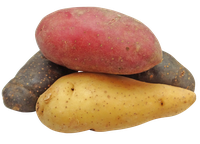Prairie Fare: You Say ‘Po-tay-tah’ and I Say ‘Po-tay-toe’
(Click an image below to view a high-resolution image that can be downloaded)
“Are we going to ‘po-tay-tah’ days this year?’ my husband asked.
“Yes, of course, we are going to ‘po-tay-toe’ days,” I replied, with an emphasis on “toe.”
He thinks I have a Minnesota accent. I think he has an Indiana accent. We probably have a bit of a Fargo accent after all these years.
“Did you remember to close the ‘win-dahs’?” I asked before we left home.
I like to tease him now and then. He grinned at me.
For years we have made our annual trip to Barnesville so I get my fill of potato dumplings at “Potato Days.” When we were first married, my husband thought potato dumplings were kind of strange.
I bought us potato dumplings at one booth, and he bought mashed potatoes and gravy from another booth. We cleaned our plates.
Savoring potatoes, especially dumplings, at this festival makes me feel nostalgic.
Potatoes are the top-consumed vegetable in the U.S., according to a recent consumer survey. Tomatoes, onions, carrots and lettuce round out the top five vegetables.
Potatoes are nutritious. They also are versatile ingredients on the menu that can be prepared in numerous ways.
These tubers grow well in the Red River Valley and supply ample complex carbohydrates to fuel our bodies. They are an excellent source of vitamin C. One potato provides about 45% of the daily vitamin C recommendation.
Vitamin C is an antioxidant that helps protect our cells; it boosts our immune system and helps maintain healthy skin.
A 5-ounce potato provides about 20% of the daily recommendation for potassium. Potassium is essential for maintaining a healthy blood pressure, and it is involved in muscle contraction and nerve transmission.
When possible, consume the potato skin, which is a rich source of fiber. If you must peel, be sure to peel thinly. The area right below the skin (the “cambium”) is where many nutrients reside.
On average, one potato has 100 calories, 4 grams (g) protein, 26 g carbohydrate and 3 g fiber.
If you add bountiful toppings to your potato, then you will add numerous calories. Try chili and a light sprinkle of cheese on a baked potato.
Potato dumplings (or “klubb”) were a favorite when I was a child. My mother learned how to make the dumplings from my great-aunt Christina, who came to the U.S. from Norway in the late 1800s.
Making the dumplings did not involve a recipe. My mother used an old stainless steel food grinder, and then she added all-purpose and whole-wheat flour and some other ingredients. Next, she boiled the potato balls in a large pot of boiling ham broth.
Some people put a cube of ham in the center of the dumpling before boiling. We had ham on the side.
This summer I was engaged in the creation of a community cookbook with several dietetic students and community gardeners. We prepared about 75 recipes and the gardeners contributed their recipes and served as the taste-testers.
Some of the submitted recipes were “heritage recipes” enjoyed since childhood. All of the recipes included vegetables and fruits we can grow in our area.
I noticed that Swedish potato dumplings were on the recipe list. Would these taste different from Norwegian potato dumplings? They called for white flour so they were lighter in color than the potato dumplings of my youth.
My students had not prepared dumplings previously, but they followed the directions exactly. The Swedish dumplings tasted a lot like Norwegian dumplings. They were very good.
This recipe was contributed by Janna Diggs for our upcoming “Growing Together” community cookbook with recipes submitted by gardeners. The cookbook will be posted online this winter.
According to the note submitted with her recipe, Janna’s grandmother was 100% Swedish, and this was a favorite family recipe. They called them “crops” instead of the Swedish word “Kroppkakor.”
Swedish Potato Dumplings (Kroppkakor)
6 c. baking potatoes, peeled and grated raw
1 tsp. salt
1 tsp. baking powder
About 5 c. flour
2 lb. cubed side/salt pork or ham
1 lb. salt pork, cut into 2-inch strips (or ham)
Fry side/salt pork until crisp. Cool and drain on a paper towel. With a food processor, grate raw potatoes. Pour off water that accumulates. Mix grated potatoes, salt, baking powder and flour. Mixture will be similar to a bread-like dough but sticky. Wet hands and roll a handful of mixture into a ball (approximately the size of a small orange). Create a pit in the ball of dough and fill with a small spoonful of fried pork. Close and seal the opening and reform into a ball.
Drop the balls into a large pot of boiling, salted water so the dumplings are covered. Lower heat to a slow boil. Cook uncovered for about 45 minutes. Depending on the size of the dumpling, cooking may take anywhere from 30 minutes for smaller dumplings to 60 minutes for larger ones. As they cook, move the dumplings so they don’t stick to the bottom. They will float up as they cook. Once they float, cook for another 10 minutes. Remove dumplings with a slotted spoon. Serve with the fried side/salt pork and cranberries, and pour cream over the dumpling.
If there are leftovers, we cube them and reheat them in a frying pan, and then serve with lots of cream poured over them.
Makes 18 servings. Without cream or butter, each serving has 210 calories, 1.5 g fat, 1.5 g protein, 41 g carbohydrate, 1 g fiber and 480 mg sodium.
(Julie Garden-Robinson, Ph.D., R.D., L.R.D., is a North Dakota State University Extension food and nutrition specialist and professor in the Department of Health, Nutrition and Exercise Sciences. Follow her on Twitter @jgardenrobinson)
NDSU Agriculture Communication - Sept. 9, 2021
Source: Julie Garden-Robinson, 701-231-7187, julie.garden-robinson@ndsu.edu
Editor: Elizabeth Cronin, 701-231-2721, elizabeth.cronin@ndsu.edu




